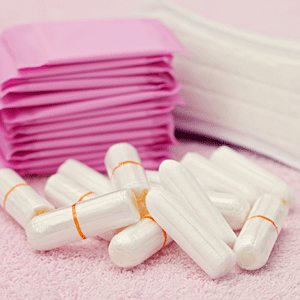
Along with gut-wrenching pain are those other not so fun symptoms — bloating, nausea and migraines. Mother Natures’ way of saying congratulations you’re not pregnant. Although I’m sure most of us would be prefer to get a congratulatory e-card instead.
About 80% of women will experience dysmenorrhoea, the clinical term for menstrual cramps. And at least 50% of these women will seek some form of medical treatment.
There are two types of dysmenorrhoea, primary and secondary. Most women suffer from primary dysmenorrhoea, which is menstrual pain that is not caused by an underlying disorder of the uterus or pelvis. The pain usually starts a few hours before and lasts until the second day of menstruation. While scientists have yet to discover what causes this pain, it’s understood that the hormone prostaglandins is responsible for general symptoms such as migraines, nausea and cramps. The more of this hormone a woman has, the more severe her symptoms are.
Read more: 5 types of period cramps that could signal a serious problem
Secondary Dysmenorrhoea is painful menstruation that is the result of an underlying disease or pelvic pathology such as endometriosis or pelvic inflammatory disease. The pain usually starts a week before menstruation.
While exercise and anti-inflammatory medication can be used to ease the symptoms of dysmenorrhoea, it doesn’t always work. According to this study conducted in the UK, one in five women experience dysmenorrhoea so severe, it interferes with their daily actions, while this Canadian study found that 51% of women reported that their activities were limited during menstruation as a result of dysmenorrhea, and 17% of them reported missing school or work.
Last year, John Guillebard, professor of reproductive health at University College London, told Quartz that some patients described the pain as being as bad as a heart attack. Yet despite how intense dysmenorrhea can be, women still suffer in silence. How many times have you seen a woman doubled over her desk because her period pain was so severe?
Read more: Could this herb be the cure for your never-ending period pains?
Guillebard also stated that even practising doctors aren’t prepared to take period pain seriously. “I think it happens with both genders of doctor. On the one hand, men don’t suffer the pain and underestimate how much it is or can be in some women. But I think some [female] doctors can be a bit unsympathetic because either they don’t get it themselves or if they do get it they think, ‘Well I can live with it, so can my patient’, ” he says. He attributes this as the reason why menstrual cramps aren’t considered important enough to research.
While we’re waiting for scientists to come up with the ultimate quick fix to cure period pain (how amazing would that be?), a simple solution would be to allow women to take menstrual leave. The pain might still be there, but we’d all be able to suffer in comfort.
We recently conducted a poll on twitter to find out whether the idea of menstrual leave would appeal to twitter users.
Do you think women should get time off work for 'period pains'? https://t.co/Og1BdVMSIw??
— Women's Health SA (@WomensHealthSA) July 4, 2017
Many were emphatic that women should be allowed menstrual leave.
I clicked yes because there are some really hectic periods that require a lady to stay at home for that week.
— Sphe (@Sphesihle49) July 4, 2017
Absolutely yes. Suffered through the pain yesterday and today. Still in pain med don't work most times. In so much pain even as i tweet.
— Mhana Vana (@Tintswalob) July 5, 2017
i remember how i used to suffer at work, some women get pains worse than others and they should get leave
— Priya Sewnath (@PRajcoomar) July 4, 2017
More recently, in 2015, Zambia became the first African country to allow women to take menstrual leave, while the Italian parliament is currently considering passing this bill.
Aside from countries passing this law, individual companies such as Nike (on a global scale) and British company Coexist, have stipulated that women are allowed to take menstrual leave. Bex Baxter, a director of Coexist, told the Independent that there’s a misconception that giving women time off makes a business unproductive. “This is not about employees taking more time off but working more flexibly and efficiently around their menstrual cycle and encouraging a work-life balance,” she explained.
The idea of menstrual leave is not a new one. In 1947, Japan passed a law allowing women to take menstrual leave. This law, however, doesn’t stipulate if this should be paid or unpaid leave. Indonesia followed suit in 1948, allowing women to take two days of menstrual leave per month. South Korea and Taiwan also allow women to take menstrual leave.
Read more: Period shaming is never okay and Janelle Monáe agrees!
Other arguments against women being allowed menstrual leave include women being further discriminated against in the work place. Companies might hire men over women as they wouldn’t need to take this leave. Some argue that women might potentially abuse this leave. This could be why 37 respondents believe that women shouldn’t be allowed to take menstrual leave.
It’s clear that there are issues surrounding the regulation of menstrual leave. But we shouldn’t dismiss the idea entirely. Instead we should make this idea feasible. Women have suffered in silence for too long.
What do you think? Should women be allowed menstrual leave? Let us know via Facebook or Twitter.
Worried about whether your period is ‘normal’ or not? Here’s what your period blood consistency says about your health, plus you should really know these 10 things about your period.
This article was originally published on www.womenshealthsa.co.za. Image provided by iStock.




 Publications
Publications
 Partners
Partners










